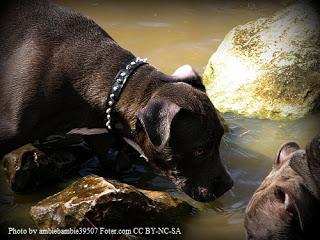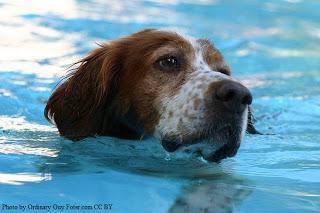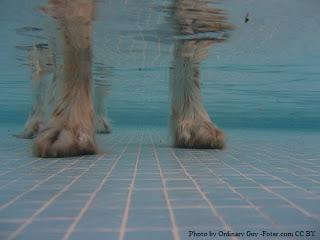By Stacey Gonzalez

Internal Server Error Foter.com CC BY-NC-ND
With the summer months soon approaching pet parents are getting excited for some fun in the sun with their canine companions. When the weather gets hot you may be tempted to take a dip with your dog but before you take the plunge make sure you know your safety rules- and know your pet.Swimming and other water play with your dog can be a bonding experience for you both. It can also keep both you and your dog in shape and provide relief from the hot summer sun. Whether you go to a swimming destination or are just swimming in the backyard pool it’s better to be safe than sorry.
Start with the basics. First you must determine that your dog is physically capable of swimming. If you have any worries or doubts about your pets swimming capabilities it is best to consult your veterinarian. It is not recommended that you take a puppy under 18 months out for this type of activity. Senior dogs should be observed closely as they may have health issues that will make it more difficult for them to enjoy the water. If you are really unsure test your dog in the bath tub, kiddie pool or any other controlled area to see how it reacts.
Slowly introduce your dog to water. Some dogs will only paddle with their front legs which makes their rear end sink into the water. The dog will then become totally vertical in the water and could possible drown. It is possible for a dog to drown. Short-legged and dense-bodied dogs such as Pugs and Bulldogs can’t swim because their bodies just aren’t designed to. Get to know your breed but don’t assume all dogs are the same. It is important to remember that all dogs are different and to never assume that your dog can swim.

Positive reinforcement can go a long way when teaching your dog to swim. Make sure you observe your dog closely at the water’s edge. Some dogs are thrown off by waves and it can take some getting used to. Be aware of any rip currents in the area. Planning ahead can prevent accidents and expensive vet bills in the future.Secondly and most importantly be sure your pet is up to date on all vaccinations and medication to prevent fleas, ticks, ear mites, worms and all other parasites. The most important vaccination in regards to swimming is the Leptospirosis vaccine. It will protect your dog against the Leptospira bacteria that causes this infectious disease. Puddles, slow moving streams and other stagnant water can harbor the bacteria. Infected wildlife that your pet may encounter on a trip to the lake can also infect your pet.
Thirdly make sure your dog has proper identification- whether its tags or microchip- just in case the two of you get separated. It’s better to prepare for emergencies ahead of time and be aware of your surroundings at all times.


A lot of pet parents love swimming in their pools with their furry family members during the hot summer months. This can allow you to swim with your dog without the fear or sharp rocks on the bottom or predatory marine creatures. Although humans can handle swimming in chlorinated pools a dog’s ears, nose and eyes are much more sensitive to the chemical. It is not recommended that a dog swim in a chlorinated pool and dogs should never drink large amounts of chlorinated water.Purchasing a dog friendly pool cleaner can reduce vet bills down the road. If you chose to allow your dog to swim in a chlorinated pool use low levels of chlorine and always rinse your dog down with fresh water prior to the swim. Make sure the ears are clean and dry- especially if you have a floppy-eared dog. Provide safe, clean drinking water for your pooch close by so that it has no reason to drink from the pool.

If you plan on having your dog poolside in the summer time it may be best to fence-in the area around the pool. That way you can close off the pool area when you don’t want your dog to go in the water. This will allow you to let the dog outside without having to worry about the risk of drowning.When it comes to swimming and other water sports with your dog it’s pretty much hit or miss. But that doesn’t mean that all dogs can’t enjoy water in their own way. Every dog is different and the best thing about introducing water to your dog is learning and discovering together. The bonding experience is extremely rewarding and the health benefits are many. So test the waters with your dog and you never know- you just may dive into a whole new relationship with your best doggie friend!
Dog swimming checklist:-Towels to dry off dog, ear wipes
-doggie life preserver of other floatation device designed for canines
-Plenty of fresh, clean drinking water and a bowl to serve it
-First aid kit that also includes quick stop, tweezers for removing ticks, contact information for nearby emergency veterinary service
-Sunscreen for dogs with close cropped fur, light coloured nose or sensitivities to the sun
-Food, treats and other training tools
-Doggie hat to prevent heat stroke
-Umbrella or another tool used to provide shade
-Poop bags and something to keep them in until you can find a garbage can
-Leash and collar with identification
-Paw protection wax for hot sand
-Floating toys
